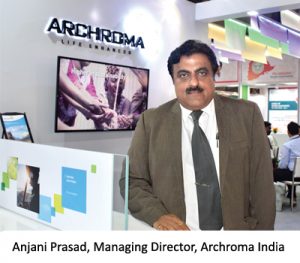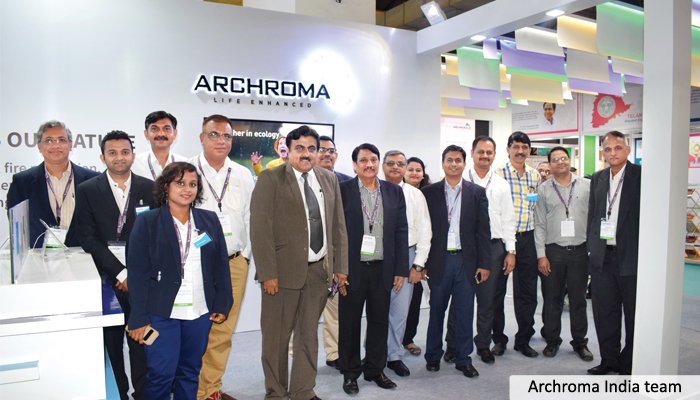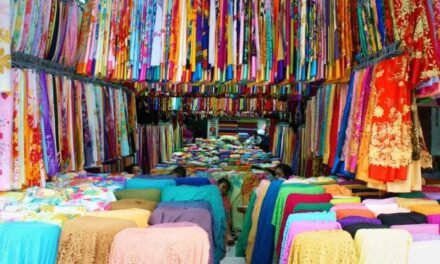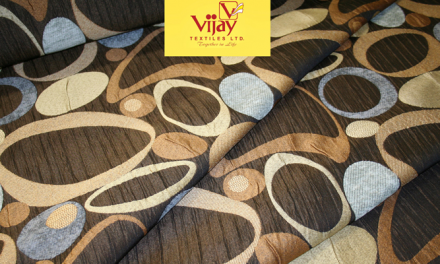Archroma, a global leader in colour and speciality chemicals recently displayed its broad portfolio of solutions for textile mills and nonwoven manufacturers at Techtextil India 2017. Under the motto, “IT’S OUR NATURE / colour, fire protection, repellence & release, coating solutions,” Archroma’s experts highlighted innovations and solutions for technical textile at “Innovation Sessions.” The company introduced solutions in the following areas:
Fire protection
Archroma made a commitment back in 2011 to use only non-halogenated technologies for its global range of Pekoflam® products. This range is ideally suited to help customers face today’s ecological challenges and fulfill ever stricter safety regulations, regardless of the application. The company’s non-halogenated portfolio includes select products that are assessed for compliance to labels such as GOTS or OEKO-TEX Standard 100 and that are in line with today’s global requirements for industrial and consumer safety.
Repellency & release

Archroma’s innovative next-generation fluorochemical alternative is PFOAfree* C6 Nuva® N supporting the switch away from long-chain fluorotelomer products that may contain PFOA (Perfluorooctanoic Acid). These products provide long-lasting and excellent repellency and release effects, are easy to handle and non-sensitive regarding compatibility with other finishing chemicals. They allow covering the full spectrum of repellency and release needs in technical textile applications.
Smartrepel® Hydro, meanwhile, is Archroma’s nature-friendlier protection that keeps cotton, polyester and polyamide textiles dry. The unique technology offers exceptional, durable water repellency and is not based on fluorine. Smartrepel® Hydro produces a soft hand feel and outstanding breathability – perfect for any weatherproof garment.
Coating package solutions
Polymer-based coating technology can be used to apply functional additives on the surface of fabrics. Archroma’s portfolio of water-based, solvent-free polymers – Appretan®, Lurapret® and Texapret® – allow handle and surface adaptations, from soft to hard, elastic to rigid, hydrophilic to hydrophobic, heat sealable to highly durable, impermeable to breathable, with low or no formaldehyde content.
They also can be combined with finishing specialties, such as Pekoflam® fire retardants, Nuva® N and Smartrepel® release and repellence solutions, and Sanitized® antimicrobial products. These products allow for more sustainable, tailor-made coating solutions for applications such as technical textiles, automotive, nonwoven, personal protective equipment and sportswear.
“These products reflect our commitment to deliver responsible products and solutions,” States Anjani Prasad, Managing Director, Archroma India, and Head of sales for Brand Performance Textile Specialties India, Nepal, Sri Lanka said while speaking exclusively to Arvind Kumar, Editor, Apparel Views. “This will help our customers in adopting products and processes that offer cutting-edge functionality while also being safer and more environmentally friendly. After all, it’s our nature!”
“We are executing ambitious growth plans, organically and through acquisitions. Since Archroma was formed in October 2013 from the textile, paper and emulsions businesses of Clariant, we have acquired the global textile chemicals business of BASF and a 75 per cent share of M Dohmen SA, an international group specialising in the production of textile dyes and chemicals for the automotive, carpet and apparel sectors. So we have lots of strength in terms of knowledge & experience. We cover from fibre to finish at garment stage and have become one stop shop arrangement for our customers,” said Prasad.
When it comes to textiles, which area does he thinks industry is moving, on this he said, “After demonetization and GST implementation the Indian textile industry is getting more concentrated. The whole chain got disturbed after these moves, so first step is to get those things right, once done it will be important as how will we get scale of operation. Textile industry has always been pushed behind by ecological manufactures. It’s important that we take care of the size of operation, so our customers if they have not reaching to the breakeven after their investment in waste water they will not be able to make money. There are many small companies who are unable to make money, hence have closed down. Consolidation of the industry will be there but we are not able to take care of China downfall by having investments, so business is going more towards Sri Lanka, Vietnam, and Ethiopia. India has to look at where all it can grow; we have very good apparel knowledge, textile raw material base, but everything is in challenge because we are weak at garmenting.”
Speaking on the challenges faced by the Indian processing industry Prasad said, “Processing is definitely a very important part of the chain but there are not many people who could invest in water and waste water management, following the govt. norms completely. There are some big companies increasing in size, but overall when you look at, there are many companies who have closed down. Recently 23 units in South closed. Rajasthan and Ludhiana are also in trouble because they don’t have common effluent treatment plant, so that’s a big challenge. To solve this problem, govt. has to become aggressive in creating garmenting hubs with common ETP facilities within the reach of these factories.”
“Processing technologies are evolving well in India, especially in areas such as home textiles. In apparel, the scale of operation is still low there. There are some sectors in Ludhiana for polyester and knitwear where some of the leading brands are sourcing from, but are still not to the level of Sri Lanka in terms of processing technology. Besides, in terms of garmenting, both Sri Lanka and Bangladesh are ahead than us, so India still has away to go,” adds Prasad.
So, how does he see scope of India, with all these problems, in world market? On this, he said, “With our overall cost of power, labour etc. we are not able to compete against Sri Lanka, Vietnam and Indonesia. But, there is a lot of pressure on the processing industries, globally and in countries like China, to reduce pollution, and produce garments and fabric in a more sustainable manner. This is where working with a partner like Archroma, reliable and committed to sustainability, makes a difference.”
Commenting on the importance of technical textile industry for Archroma, Prasad said, “Currently, it would be around 8-10 per cent of our portfolio, basically there are very high speciality products for technical textile segments in this. This segment is growing as the consumption and per capita income is growing, so demand is increasing especially in automotive, sportswear, productive wear, hospitals and other segments. For Archroma it is going to be a very important sector in future.”
When asked about the current market scenario and Archroma’s future he said, “Demonetization and GST had small impact on us. In last one year we have been able to do very well in sectors like denim, and also performed doing quite well in apparel and home textiles also. As far as industry is concerned, India is still not competitive enough against countries such as Bangladesh and Vietnam, and they are gearing up. Even Sri Lanka is attracting investors using levers such as low taxes, and this helps to grow faster in those areas as compared to India. Machinery investments are very high in these industries; so, lower taxation of machinery imports could be a good incentive.”
“Archroma is a global company, so wherever the market shifts, it shifts accordingly. We have to squeeze or increase depending on the market so that is how it works. When it comes to future of Indian textile industry, it will not jump but there will be leaps and bounds, after which it will grow. Looking at all the challenges, Archorma will be more focused to boost our growth in India. We aim to become the preferred supplier in all of the industries we serve. We clearly remain fully focused on our strategy to further grow organically and through acquisitions,” concluded Prasad.






















